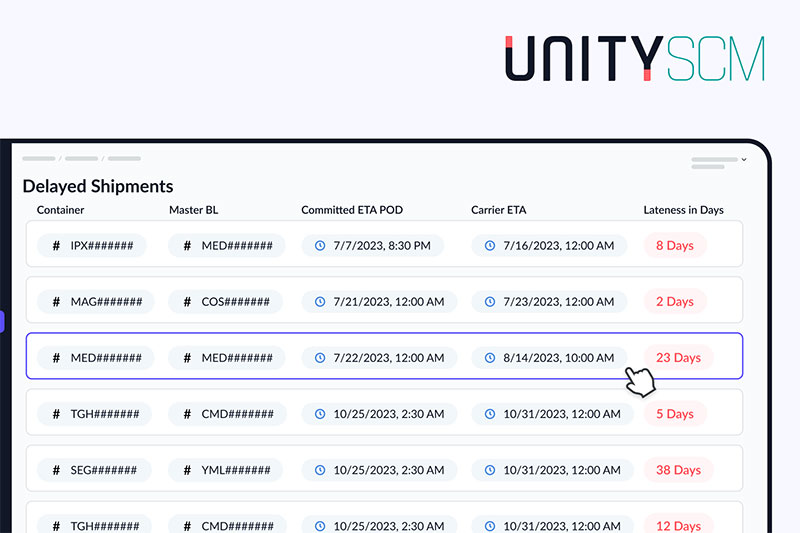Keep Your Operations Working Like They Should
Every organization has vulnerabilities, ranging from unavoidable single-sourcing to under performing partners and poor network design, that can make them more susceptible to threats and disruptions. By implementing best practices to reduce these vulnerabilities, your organization can minimize potential disruptions from supply chain threats.
Essential Practices for Preventing Supply Chain Disruptions
A proactive approach is vital for keeping supply chain disruptions from creating major challenges for your organization. The following strategies are a must for any organization:
Real-time shipment tracking eliminates variables and blind spots, providing an early warning for everyday logistics issues such as port disruptions or schedule changes. With real-time exception management, leadership can proactively detect and address issues before they become major disruptions — often weeks in advance.
-
Increase Visibility to Minimize Blind Spots
A lack of visibility is one of the most significant contributors to supply chain disruptions. Every supply chain has multiple points of failure, and continuous diagnostics are needed to identify and mitigate them. However, without adequate data from 3PLs and other partners, it becomes nearly impossible for organizations to ensure product availability or optimize staffing levels. When teams consolidate multiple reports from different partners, they can lose several days, falling behind in responding to disruption.
-
Know Who You Can Count On
Relying on a single supplier puts your business at significant risk of disruption. Civil unrest or a severe weather event could render a supplier completely unusable for an extended period. Knowing which suppliers and other logistics partners you can rely on can help you continue to fulfill shipments even if one supplier’s operations are disrupted.
One way to do this is to analyze lead times to compare the performance of carriers and suppliers, as well as industry benchmarks for similar routes. With detailed insights, you can better know your network and make informed decisions to select and prioritize the best-performing carriers.
-
Develop a Risk Management Plan That Supports Agile Operations
A sound risk management plan must support supply chain strategies. A risk management plan should encompass prevention and preparedness strategies and response and recovery plans. By thoroughly evaluating all potential risks to your supply chain (from a hurricane to staff restructuring), you can develop agile operational strategies specific to those disruptions that allow you to respond quickly.
By combining a sound risk management strategy with quality data, you can take a more proactive, agile approach that limits the impact of potential disruptions.
How Real-time Data Can Help
While the previously mentioned steps are useful, they all rely on having access to real-time data from critical sources in the supply chain. Crucial information such as ETAs and up-to-date performance, cost and reliability data for every node of your network (with a special focus on terms and conditions for unplanned events) helps organizations identify shipments at risk of detention and demurrage charges, measure lane/carrier/freight forwarder performance, and so on.
Effective supply chain diagnostics requires full visibility to identify vulnerabilities like production bottlenecks or excess costs. Combining both the descriptive analytics and diagnostics (the what and the why) makes it easier for organizations to proactively detect risk, collaborate to analyze and resolve these risks, and use data to identify new opportunities for improvement.
Unity SCM‘s platform is designed to seamlessly integrate diverse data sources and streamline the flow of information across the entire supply chain infrastructure, enabling businesses to make faster, better informed decisions that prevent import disruptions and reduce costs. In particular, Unity SCM helps consolidate container tracking data and then enriches that information with inventory data and purchase orders to provide full end-to-end visibility and exception handling.
“Access to enriched data from third-party sources enables a proactive approach toward supply chain disruptions, helping users reduce operational costs and enhance efficiency,” explains Amir Taichman, CEO of Unity SCM. “Having the ability to prevent production disruptions caused by missed quantities from suppliers allows organizations to avoid manufacturing downtime, inventory shortages, and other common issues stemming from supply chain disruptions. Having that real-time information from a single, reliable source of truth allows for better planning and decision-making, which goes a long way in addressing supply chain vulnerabilities.”

Example of Unity SCM’s “Delayed Shipments” Report
When faced with disruptions caused by low water levels in the Panama Canal, Unity SCM’s automated reports helped organizations identify shipments at risk of disruption from this issue (including purchase orders and inventory in-transit data). With this information, they could make informed decisions on re-routing shipments or filling inventory gaps. This capability helped platform users avoid tremendous losses that might otherwise have occurred due to product spoilage, inventory shortages, and manufacturing downtime from delays in receiving raw materials.
A Comprehensive Solution Is Key
To consistently prevent disruptions, a comprehensive solution is essential. When every operator on your team has the necessary information, key insights from across your supply chain with added context, and tools to help them resolve issues, they can proactively and flexibly address any crisis.
With such solutions in place, you can have complete visibility backed by comprehensive real-time data — even when disruptions would otherwise cause significant problems. With a well-defined risk management strategy supported by a platform like Unity SCM, organizations can take a proactive approach that successfully manages disruptions for years to come.
For more information, visit unityscm.com.
SC
MR


More Risk Management
- Israel, Ukraine aid package to increase pressure on aerospace and defense supply chains
- How CPG brands can deliver on supplier diversity promises
- How S&OP provides the answer to in-demand products
- There is still work to do to achieve supply chain stability
- Blooming success: The vital role of S&OE in nurturing global supply chains
- How one small part held up shipments of thousands of autos
- More Risk Management
Latest Podcast

 Explore
Explore
Topics
Procurement & Sourcing News
- Israel, Ukraine aid package to increase pressure on aerospace and defense supply chains
- How CPG brands can deliver on supplier diversity promises
- How S&OP provides the answer to in-demand products
- There is still work to do to achieve supply chain stability
- Blooming success: The vital role of S&OE in nurturing global supply chains
- How one small part held up shipments of thousands of autos
- More Procurement & Sourcing
Latest Procurement & Sourcing Resources

Subscribe

Supply Chain Management Review delivers the best industry content.

Editors’ Picks




